Battlefield 1 optimal graphics settings. Check the minimum requirements. Impact of settings on performance and quality
Battlefield 1 may be stunningly beautiful, but good graphics requires large computing power. So for more weak systems Performance and optimization problems may appear, some of which can be easily resolved.
First of all, it is worth noting that the game will officially be released on October 21 and on the launch day, Battlefield 1 will most likely receive a patch that can solve some of the problems. But the tips below will still not be superfluous.
If you have problems with frame rate drops and picture twitching, there are several solutions:
Check minimum requirements
Just in case, let me remind you of the minimum PC requirements on which Battlefield 1 is guaranteed to run:
OS: Windows 7/8.1/10×64 Processor: AMD FX-6350 / Core i5 6600K (Skylake) RAM: 8 GB Video card: Radeon HD 7850 2GB / GeForce GTX 660 2GB HDD: 10+ GB hard drive, but better to use SSD
And don’t forget to look inside the PC - dust and dried thermal paste on the processor quickly overheat the system and sharply reduce its performance.
Lower graphics settings
This may be trivial, but it is always worth checking whether the automatic settings optimizer made a mistake for the system data. However, sometimes it happens that this does not help - the problem lies in something else.
You can also try switching from DirectX 12 to DirectX 11 - some games work with previous version more correct.
Disable video card memory limit
For some reason, Battlefield 1 has the limitation enabled by default. available memory graphics processor, that is, the game does not use the full potential of your video card for its needs.
To get rid of restrictions, go to the advanced graphics settings menu and uncheck the corresponding item.
Check drivers
Most of the problems with new PC games are most often related to video card drivers, especially new ones like GeForce GTX 10xx or Radeon RX 9xx - you will have to wait until Nvidia and AMD release the necessary update and everything will immediately get better.
Or it is possible that the driver has already been released, but did not have time to download automatically from you - always check the freshness of the drivers before starting new game, especially one as large and demanding as Battlefield 1.
Turn off everything unnecessary
If you are experiencing performance issues, try to provide your PC with the best possible operating conditions:
Disable Origin Overlay in Manager Windows tasks(Ctrl+Alt+Del) find the Battlefield 1.exe process and give it maximum priority Disable Xbox GameDVR Disable (or delete altogether) Nvidia GeForce Experience and Nvidia Shadowplay IN as a last resort disable your antivirus, some “eat up” a lot of resources Read also: Review of Battlefield 1 Amazing screenshots of Battlefield 1 Amazing art of Battlefield 1 How to best screenshots on PC? Guide: how to play for which class?
Sergey Plotnikov,
October 23, 2016, 18:00
Exists a large number of cult game series. Gamers are going crazy for GTA The Elder Scrolls, Diablo, The Witcher and many other projects. The franchise, affectionately called “Battle”, also belongs to the cohort of games that are eagerly awaited. Therefore, it is absolutely understandable why the public is so concerned about one question: what hardware is enough to safely play the brand new Battlefield 1?
The site's board of editors decided that DICE and EA's Battlefield 1 turned out to be very beautiful. Especially in retrospect, when you compare, just imagine, the 14th and most recent part to date with all the others. Which, by the way. No, it doesn’t smell like nextgen. The core of Battlefield 1 is time-tested and honed by projects such as Star Wars: Battlefront and Mirror's Edge: Catalyst, the Frostbite engine Engine versions 3.5. But the first World War in the vision of game designers, DICE turned out to be very atmospheric and spectacular. NVIDIA has a beautiful advertising slogan: “ play as intended" Let's see which modern video cards are suitable for comfortable gaming in Battlefield 1.
System requirements and graphics quality
Many users were alarmed by the fact that the system requirements recommended by the developer for Battlefield 1 include very powerful iron. Namely, you need an eight-core/eight-thread processor, 16 GB random access memory and a video card of the Radeon RX 480 or GeForce GTX 1060 level. The “” section suggests that you will have to pay at least 50,000 rubles for such a system.
With the release of Battlefield 4, the Frostbite Engine was taught to work with low-level software interface. With the advent of Battlefield 1 came support. The main goal of this API is to get the most out of graphics adapter, unloading the remaining components. In particular, the central processor. For now, DirectX 12 is more of a marketing effort to force gamers to upgrade to Windows 10.
And yet, there are more and more games supporting the new API. Battlefield 1 is perhaps the first serious project. However, by default DirectX 11 is activated in the game. This is due to the fact that the minimum system requirements include quite old cards that do not support DirectX 12. As well as operating Windows systems 7 and 8.1.
Frostbite Engine now supports DirectX 12
Battlefield 1 traditionally has four graphics quality presets: low, medium, high and ultra. Technologies such as HBAO and TAA anti-aliasing are supported. Star Wars: Battlefront has exactly the same settings. Another interesting point— the options provide a “GPU memory limit” parameter. The developer warns that if there is not enough video memory, there may be a drop in performance, that is, lags.
Mission "Work for one".
Video card performance
Test stand:
- CPU: @4.5 GHz
- CPU cooler: Noctua NH-D15
- Motherboard: MSI Z97 MPOWER
- Storage device:
- RAM: DDR3-2133, 2x 8 GB
- Power supply: Corsair HX850i, 850 W
- Operating system: Windows 10 x64
- Peripherals: LG 31MU97 monitor
- Drivers: 373.06, 16.10.2
It's funny that Battlefield 1 is quite well optimized for AMD CrossFire and NVIDIA SLI technologies. But only in DirectX 11 mode. In DirectX 12, combinations of several video cards, as well as multi-chip accelerators, do not work properly. For the experiment I took eight modern video cards AMD Radeon and NVIDIA GeForce. Six of them are listed in the table, with hyperlinks leading to reviews. Unfortunately, it is prohibited to publish GeForce GTX 1050/1050 Ti performance results until the embargo is lifted. But you can find out how these video cards behave in Battlefield 1 from the review on our website.
After testing, NVIDIA released driver 375.57, but practice has shown that the later WHQL version did not radically change the situation. It is clear that the game itself will be patched and supplemented over time. And it will also add a little in terms of productivity.
|
Video cards |
||||||||||||||||
|
Finally, it’s not at all news that the Frostbite Engine is very processor-dependent. Therefore, the number of FPS in Battlefield 1 will also be determined by the CPU. We checked this fact on the “With all our might” map.
As you can see, the low-frequency Core i5 is better than the fast Core i3. Therefore, when building a computer from scratch, it is better, for example, to take a Core i5-6400 than a Core i3-6100. But another thing is important: on all processors with four or more threads, Battlefield 1 is quite playable, although the graph below clearly demonstrates that a powerful GPU must work in tandem with a powerful CPU. Below is a small table that includes the most popular video cards.
| |||||||||||||||
It may be stunningly beautiful, but good graphics require a lot of computing power. So on weaker systems, performance and optimization problems may appear, some of which can be easily resolved.
First of all, it is worth noting that the game officially releases on October 21, and on launch day, Battlefield 1 will most likely receive a patch that could solve some of the problems. But the tips below will still not be superfluous.
If you have problems with frame rate drops and picture twitching, there are several solutions:
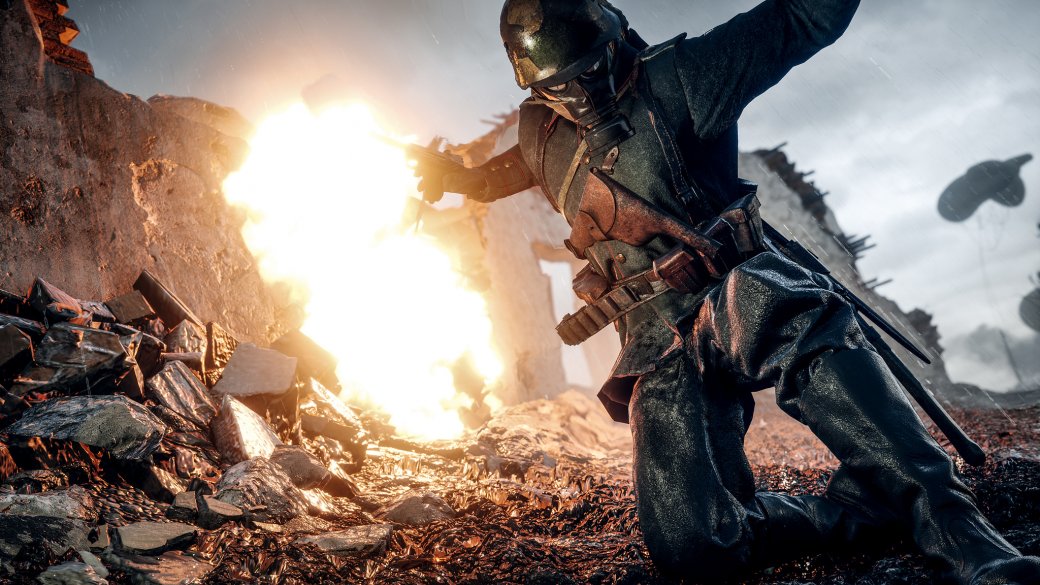
Check minimum requirements
Just in case, let me remind you of the minimum PC requirements on which Battlefield 1 is guaranteed to run:
- OS: Windows 7/8.1/10×64
- Processor: AMD FX-6350 / Core i5 6600K (Skylake)
- RAM: 8 GB
- Video card: Radeon HD 7850 2GB / GeForce GTX 660 2GB
- HDD: 10+ GB hard drive, but SSD is better
And don’t forget to look inside your PC - dust and dried thermal paste on the processor quickly overheat the system and sharply reduce its performance.
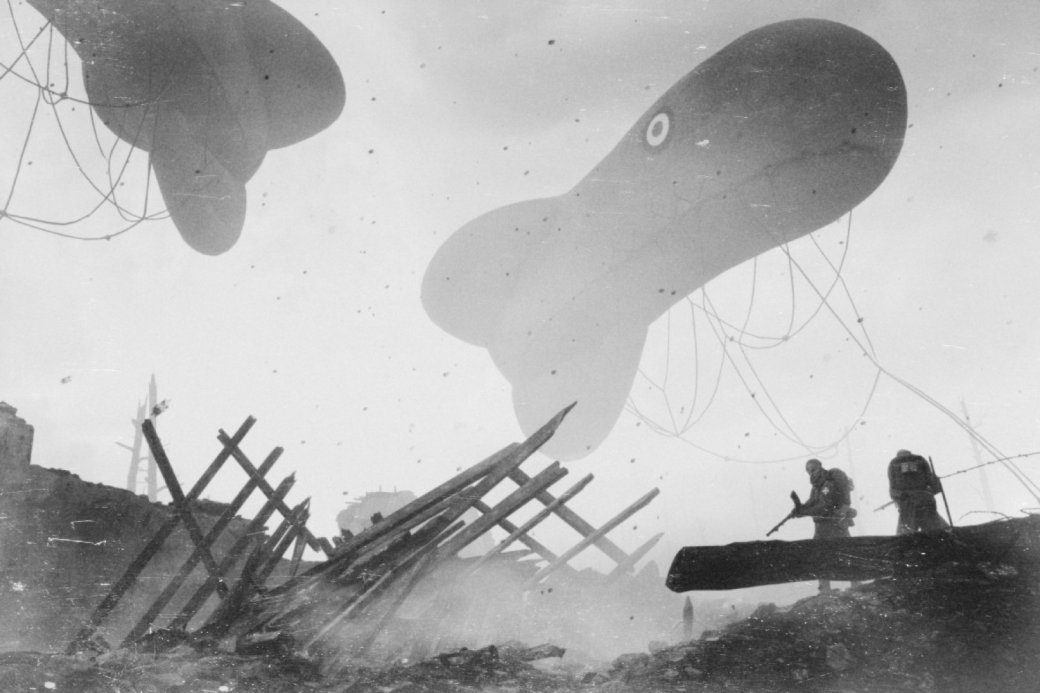
Lower graphics settings
This may be trivial, but it is always worth checking whether the automatic settings optimizer made a mistake for the system data. However, sometimes it happens that this does not help - the problem lies in something else.
You can also try switching from DirectX 12 to DirectX 11 - some games work more correctly with the previous version.
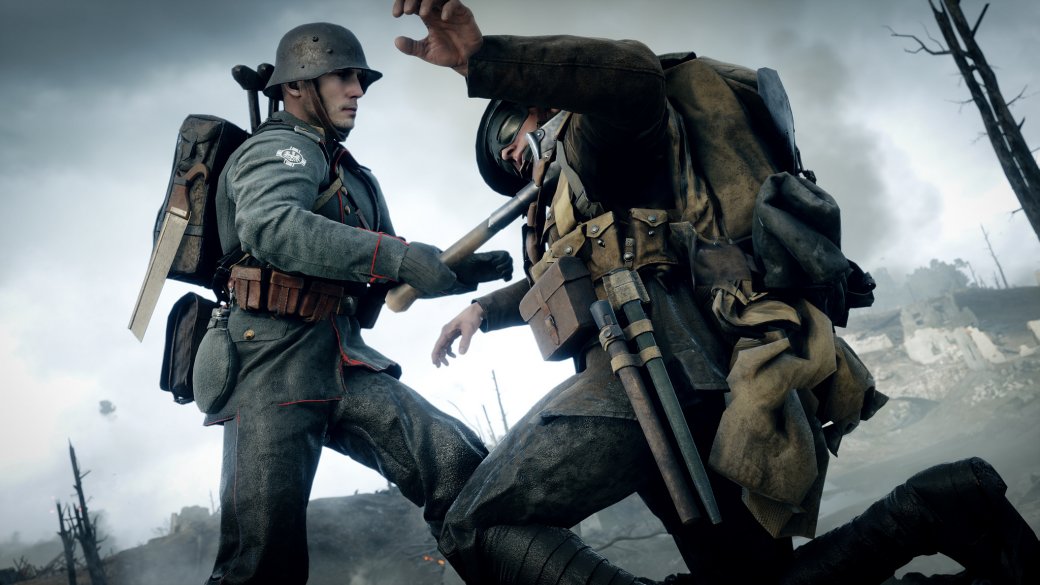
Disable video card memory limit
For some reason, Battlefield 1 has GPU memory limits enabled by default, meaning the game does not use the full potential of your video card for its needs.
To get rid of restrictions, go to the advanced graphics settings menu and uncheck the corresponding item.
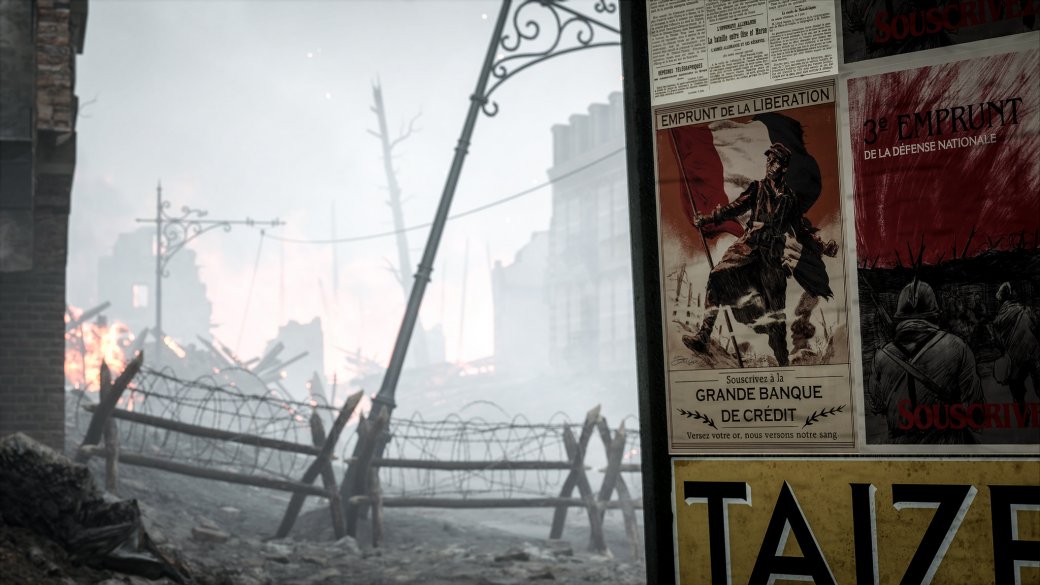
Check drivers
Most of the problems with new PC games are most often related to video card drivers, especially new ones like the GeForce GTX 10xx or Radeon RX 9xx - you'll have to wait until Nvidia and AMD release necessary update and everything will immediately become better.
Or it is possible that the driver has already been released, but did not have time to download automatically for you - always check the freshness of the drivers before launching a new game, especially one as large and demanding as Battlefield 1.
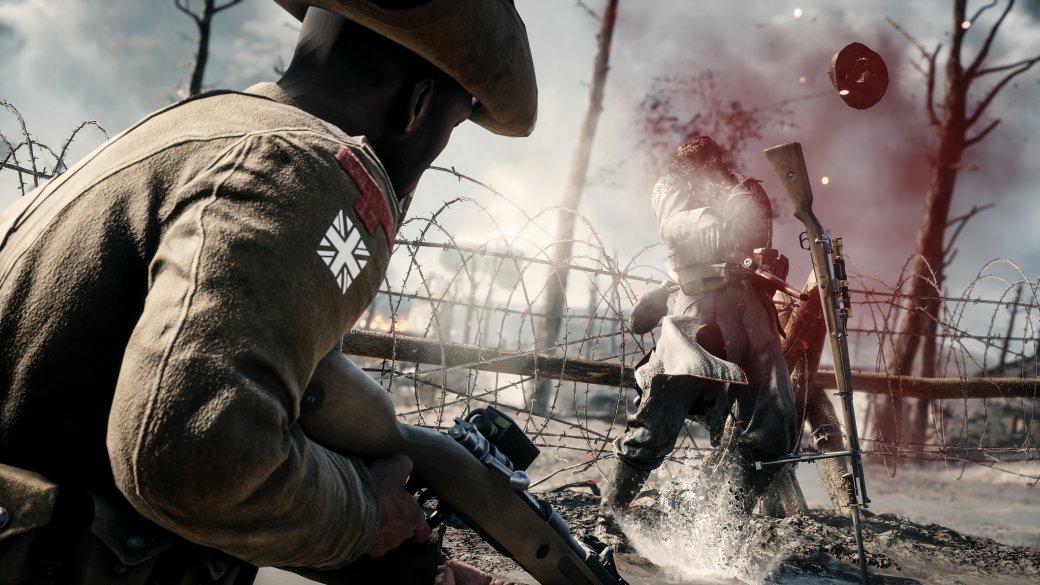
Turn off everything unnecessary
If you are experiencing performance issues, try to provide your PC with the best possible operating conditions:
- Disable Origin Overlay
- In Windows Task Manager (Ctrl+Alt+Del) find the Battlefield 1.exe process and assign it the highest priority
- Disable Xbox GameDVR
- Disable (or completely remove) Nvidia GeForce Experience and Nvidia Shadowplay
- IN as a last resort disable your antivirus, some “eat up” a lot of resources
Performance testing Nvidia video cards GeForce in the game Battlefield 1
based on Gigabyte solutions
Brief information about the game
- Release date: October 21, 2016
- Genre: First Person Shooter
- Publisher: Electronic Arts
- Developer: EA Digital Illusions CE
Battlefield 1 is a popular multi-platform first-person shooter belonging to the series of games under common name Battlefield, created by developer DICE and publisher Electronic Arts. The next game in the series was released on October 21 in versions for several gaming platforms: PC for managed by Microsoft Windows as well game consoles Sony PlayStation 4 and Microsoft Xbox One.
The fourteenth game in the series, announced in May of this year, is the same Battlefield we know, but it differs from the previous ones primarily in that it is based on historical events First World War. The very idea of the First World War at first seemed dubious to EA, but the developers from DICE were able to convince them and created an original story specifically for a single-player game with the involvement of recognized technical experts.
The unusual idea, supported by the first trailer, caused positive reviews of the game from the general public, but this was overshadowed by the fact that at the time of the game's release it was planned to represent only a few of the fighting sides: Britain, Germany, Austria-Hungary, Italy, the Ottoman Empire and even the USA , whose troops did not take as significant and long-term participation in the battles in this war as Russia and France, which participated in the war from the very beginning. The developers promise that France and the Russian Empire will appear in future expansions, at least for multiplayer games.
In Battlefield 1, players can use weapons from the era, including semi-automatic rifles, flamethrowers, artillery, and even chemical agents. For close combat, weapons such as sabers and sapper shovels appeared. But the most interesting weapons in the game are unlocked by controlling different vehicles of that time: tanks, armored vehicles, airplanes and airships. You can even ride a horse as part of the cavalry. As is typical for Battlefield games, the game in question features destructible environments that are made even more impressive.
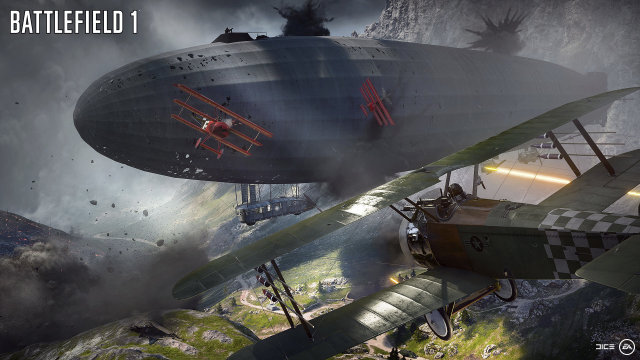
The game's single-player campaign includes large open spaces, the area is clearly larger than in previous games in the series, with several paths and the ability to choose the manner of performing combat missions. In the game, users can control six different characters, and the prologue of the game is different in that when one of them dies, control passes to another soldier with his role (machine gunner, infantryman, tank shooter, etc.), which looks fresh. Unlike previous games in the series, Battlefield 1 contains several combat stories that are not very connected to each other.
And the multiplayer mode, which is very important for games in the Battlefield series, supports battles with up to 64 players, maps for this game mode are based on various parts of the planet, including Arabia and the Alps. At release, the game features nine maps and six multiplayer modes. To test the game, an open beta test of Battlefield 1 was organized for all three gaming platforms, in which several million players participated and which lasted from late August to September and allowed to catch both technical errors, as well as other shortcomings of the early version of the game.
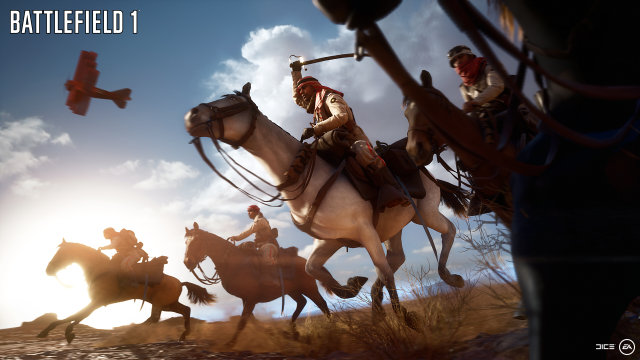
Battlefield 1 is based on the third version of the Frostbite Engine, which was developed by EA Digital Illusions CE almost a dozen years ago for use in own games company and other projects of the publisher Electronic Arts. On this moment Several versions of this game engine have been made: 1.0, 1.5, 2, 2.5, 3, 3.5 and Frostbite Go - a special version for mobile systems.
The first game based on Frostbite Engine 1.0 was Battlefield: Bad Company, released in 2008. In 2013, DICE released the game Battlefield 4, created based on the third version of the Frostbite Engine, and in May 2014, DICE and EA announced another game based on this engine - Battlefield: Hardline. Then, based on the latest version of the engine, the games Star Wars: Battlefront and Need for Speed.
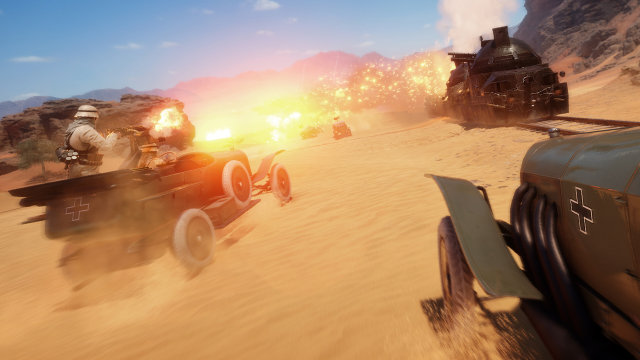
The Frostbite engine is classified as middleware; it includes several components: a graphics engine, a sound engine and others. Different versions Frostbite supports the following graphics APIs: DirectX 9, DirectX 10, DirectX 10.1, DirectX 11, DirectX 12 and Mantle ( early versions Frostbite 3). This game engine supports everything modern technologies, such as dynamic lighting and global shading (SSAO and HBAO algorithms), procedural textures and advanced bumpmapping, particle systems and various post-processing effects like depth of field. Separately, we note the excellent multi-threaded optimization for working with multi-core processors, which we will check in practice.
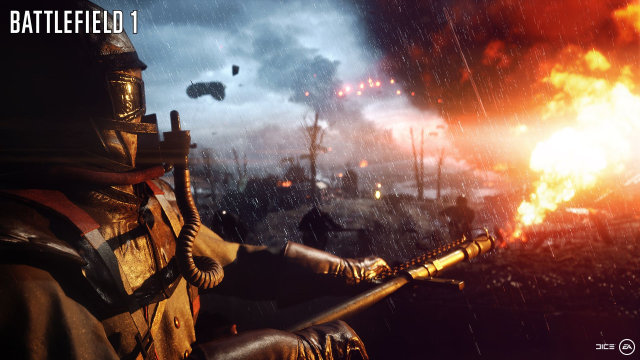
As we can see from previous games, the Frostbite engine is capable of efficiently processing and rendering large game levels filled with big amount static and dynamic objects: buildings, trees and others, most of which are destructible. The developers claim that maximum size location is limited to the displayed area of 32×32 km, and the maximum drawing distance is practically unlimited and allows you to see objects gaming level all the way to the horizon.
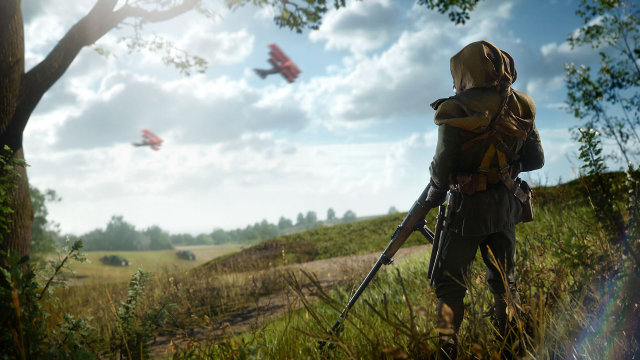
In Battlefield 1, we see excellent graphics thanks to an engine based on the Physically Based Rendering system, which takes as its basis the idea of using realistic shading and lighting models depending on the properties of surfaces to accurately reproduce real-life materials in the game. virtual world. Frostbite's state-of-the-art renderer uses a combination of sophisticated compute and pixel shaders to achieve stunning final results. The use of tessellation along with high-resolution textures when rendering the ground surface, as well as the use of the Screen Space Ambient Occlusion (SSAO) global shading technique and the improved HBAO algorithm, also adds realism.
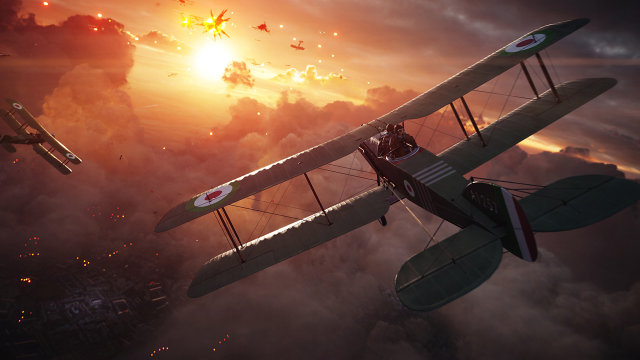
The game is distinguished by high-quality and highly detailed character models and vehicles with high-resolution textures, realistic shadows obtained using advanced algorithms and global illumination simulation are not left without attention and realistic reflections real time in all sorts of puddles and on metal surfaces, which are now very fashionable. To all this are added high-quality anti-aliasing algorithms, including those using the time component (TAA), which do a good job and are not too resource-intensive.
System requirements
Minimum system requirements:
- CPU Intel Core i5-6600K or AMD FX-6350;
- RAM capacity 8 GB;
- DirectX 11 compatible video card Nvidia GeForce GTX 660 or AMD Radeon HD 7850;
- video memory capacity 2 GB;
- free space on HDD 50 GB;
- Microsoft Windows 7/8.1/10 ;
- CPU Intel Core i7-4790 or AMD FX-8350;
- RAM capacity 16 GB;
- DirectX 11.1 compatible video card Nvidia GeForce GTX 1060 or AMD Radeon RX 480;
- video memory capacity 3-4 GB;
- free space on HDD 50 GB;
- 64-bit operating system Microsoft Windows 10;
The requirement to use the 64-bit Windows operating system has become commonplace; it helps to get away from the outdated limit of 2 GB of RAM per process. Unlike previously reviewed games released by publisher Microsoft Studios, the requirement is to use Windows 10 in in this case no, not to mention the special Anniversary Edition, which is necessary for some recent games. Although Battlefield 1 can use the DirectX 12 API, this is not at all necessary - there is no difference with DirectX 11, and the game can be run in all operating systems Microsoft, starting with Windows 7.
Requirements to hardware the game is average by modern standards, and the minimum is even quite low, considering that among the minimum suitable video cards quite old and not so powerful video cards of the GeForce GTX 660 and Radeon HD 7850 models are presented, which are really close to each other in performance. But we must not forget that this is only the bare minimum required to run the game at low settings, or at least medium.
To run the game, a system with at least 8 GB of RAM and a sufficiently powerful multi-core processor is required. Recommendations for using not the weakest CPUs are quite justified; the game was very work-intensive at any graphics settings test processor, and this applies to both multi-threading and the performance of individual cores, although the game does not rely on a single core. Those who want to play at maximum graphic settings will need gaming system already with 16 GB of memory and even more powerful Intel processor Core i7 - exactly like our test system.
To get really high-quality image with an acceptable frame rate, the developers recommend running Battlefield 1 on a system with video cards of the GeForce GTX 1060 or Radeon RX 480 level with 3 or 4 GB of video memory, respectively. These solutions are really very close to each other in terms of performance, and provide excellent gaming comfort at the highest possible quality in resolutions above Full HD. We recognize these requirements as sane and completely justified - Battlefield 1 places serious system requirements on the entire system, the game needs a high-performance CPU and a fairly powerful GPU.
Test configuration and testing methodology
Battlefield 1 is included in the marketing and technical AMD program, but Nvidia also released a special optimized version of drivers for the release of this significant project (as well as some others) - 375.63 WHQL dated 10/23/2016, intended for the games Battlefield 1, Sid Meier's Civilization VI and Titanfall 2, which we used in today's tests of Gigabyte video cards. Note that this is a patched driver released to replace version 375.57, which had some issues.
Fortunately, latest version MSI Afterburner received support for DirectX 12, which somewhat simplifies our testing work modern games. True, the Fraps utility works exclusively in the DirectX 11 version, so we also needed to use Mirillis Action! for tests. Please note that games published by Electronic Arts and distributed through digital system Origin, there is one drawback that opens up when testing video cards - this system does not allow you to run games on more than five fixed hardware configurations every 24 hours. And since changing a video card is already considered a configuration change, to test a dozen video cards we had to spend more than a day on tests.
Alas, the Battlefield 1 game, traditionally for this series, does not have the possibility of built-in performance testing, nor the ability to play back a previously recorded piece of gameplay. And so we had to take for our testing the tank mission “Over the Top” from the military story “Through Mud and Blood” from the single player campaign, which is available at the very beginning of the game, after completing the prologue. We simply measured the average frame rate in a one-minute chunk gameplay, using the Action! utility. The beginning of the mission is not too variable, includes many computer-controlled soldiers and tanks on a similar principle, and even taking into account the slight difference in the passage allows for highly repeatable results. It is clear that there is a spread in FPS between runs, but it is not too large and this option is quite suitable for express tests.
It is important to note that when testing, it is necessary not only to turn off vertical synchronization, which has long become commonplace, but also to disable the “GPU Memory Restriction” parameter that limits the settings, which can reduce the picture quality when the available video memory is filled - this ensures equal conditions for video cards with different the amount of local memory.
Playing Battlefield 1 is as comfortable as possible at a stable 60 FPS, when the frame rate never drops below this mark, and average The frame rate is about 80-90 FPS. But for not too demanding users it is also suitable average frequency frames in the benchmark start from 45 FPS, but definitely not less! Lower FPS values in the built-in performance test will result in a less smooth game experience as mouse response becomes sluggish. And we are talking about a single-player campaign; a multiplayer game will not tolerate such tolerances; it definitely needs a minimum of 60 FPS. So our benchmark can be used for evaluation, setting a minimum playable level of 45-50 FPS on average for undemanding players and about 80-90 FPS for multiplayer. At lower frame rates, the game's response to mouse movement becomes unacceptably slow.
It should be noted that optimization for multi-core central processors in Battlefield 1 is done at an excellent level. The game runs well on such processors, and a fairly new CPU does not limit the rendering speed of the game when high resolution and graphic settings. For example, the test CPU was loaded with work by 45-50% or even more, which is quite a lot even by modern standards. But at the same time overall speed not limited to just one of its cores, they were not loaded above 80-85% on average. Although the most powerful video cards in comparison are still a little limited by CPU speed at Full resolution HD and medium settings, but this emphasis is not too strong, and rendering speed is not determined by the performance of a single CPU core. This is what the loading graph looks like CPU cores for a typical game:
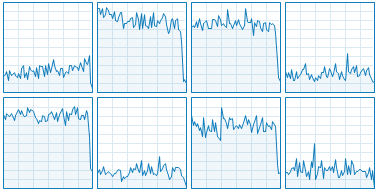
Battlefield 1 is not too demanding by modern standards in terms of video memory. At medium settings in Full HD resolution you need about 2 GB of memory, and for maximum settings you will need 3 GB. That is, video cards with only 2 GB of memory will have a hard time playing the game, but 4 GB options will handle the job easily. For WQHD resolution at medium settings you need 3 GB, and ultra-profile or even higher resolution will require 4-6 GB of video memory for smooth operation. We consider 4 GB to be the optimal amount of video memory for the game.
Impact of settings on performance and quality
Graphics settings in Battlefield 1 change according to internal menu game, which can be called up during gameplay. Changing all graphics settings, with the exception of the choice of graphics API (DX11 or DX12), is applied immediately in the game and does not require restarting the application, so adjusting the rendering quality in this game is quite convenient. If only it had a benchmark...
The Battlefield 1 graphics settings menu offers four preset settings: Low, Medium, High and Ultra. It’s very simple to describe them: when you select the High profile, all available settings are set to exactly the same level, the same is true for the other profiles. The method of anti-aliasing and simulating global shading differs only for Low, and for the rest, anti-aliasing is always performed by the TAA method, and the global shading technique is used by the HBAO method. In our work, we used the Medium (medium settings), High (high settings) and Ultra (ultra settings) profiles available in the menu without any changes:
Medium settings
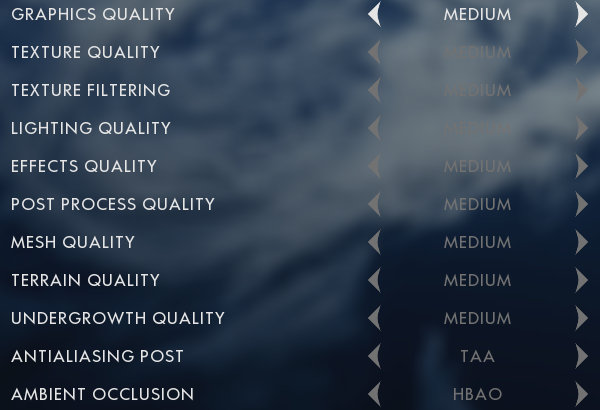
High settings
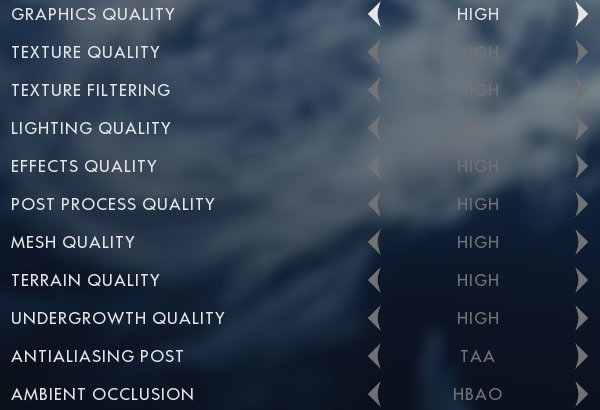
Ultra settings
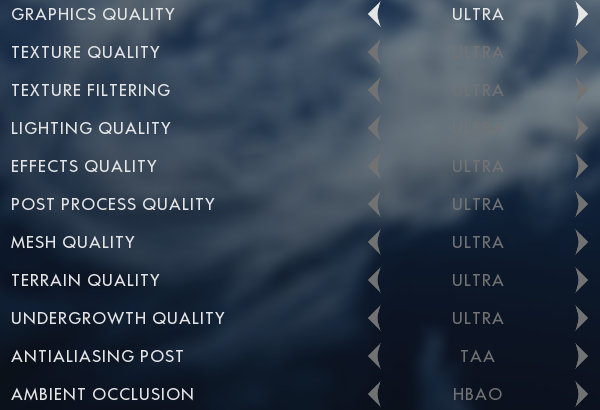
When playing, find the difference between different settings quality is not so simple, but in the dynamics the differences in the quality of rendering of the landscape and objects, lighting and shading are still visible. This is most noticeable precisely in the quality of lighting and shading, and although the difference between an image with an average and maximum quality not always clearly visible, only the highest settings give an almost cinema-realistic picture in this game.
As always, the best thing to do is to adjust the rendering quality and final performance to your requirements, based on your own feelings and FPS indicators. Moreover, the influence of some parameters on the resulting rendering quality with different settings in the game is not always noticeable. Based on the videos, it will be somewhat easier to note the different rendering quality corresponding to different levels of graphics settings.
In general, the settings profiles are well balanced. Low settings make it possible for owners of the weakest systems to play, but we would not recommend using this profile, since the difference in quality is too great, and the game is perfectly optimized even for relatively weak GPUs. All profiles are different from the ones below them, and we are talking not only about the quality of textures and geometry, but also the quality of rendering of surfaces, reflections on them, the quality and quantity of vegetation, the quality of shadows, etc.
Medium settings
Ultra settings
The graphic settings in Battlefield 1 are average, but this is quite enough, and you can fine-tune the game to suit your requirements, adjusting the final picture quality and rendering performance. In the settings menu there is like Common parameters, such as selecting the display resolution and rendering (separately, as a percentage of the display resolution), as well as the refresh rate, turning on vertical synchronization and selecting the viewing angle (FOV - Field of View), and many fine settings.
IN additional settings includes the choice of texture quality, their filtering, the quality of lighting and shadows, the complexity of post-processing effects, the geometric complexity of objects and landscapes, the choice of full-screen anti-aliasing methods and global shading Ambient Occlusion. Let's briefly look at the graphics settings of Battlefield 1, and the speed increase they give on a system with a powerful video card of the GeForce GTX 1070 level.
Resolution Scale — important setting, which we did not touch in the video card tests. This value changes the rendering resolution, set as a percentage of the screen resolution. If you have a very powerful video card and want to get more high-quality picture, you can choose 150% or even 200% to enable additional supersampling when rendering in higher resolution and adjusted to the display resolution when output. Or vice versa, if you have a weak video card that does not provide the required performance, you can set the rendering resolution to less than 100% - with a corresponding deterioration in overall quality.
In our tests of video cards, we did not change the value from 100% by default, but for a powerful GPU in Full HD resolution with maximum settings, reducing the rendering resolution to 50% gives an additional 5% to the frame rate (general emphasis on the CPU), and increasing it to 150% reduces the frame rate by a third - that is, only suitable for the most powerful video cards, like the GeForce GTX 1070 or Radeon R9 Fury X and above.
Graphics Quality— a setting that specifies the overall graphics quality when selecting one of the fixed profiles: Low, Medium, High and Ultra. There are also user profile Custom. In our tests, we used only the older three profiles without any changes in the settings.
Texture Quality— a parameter used to change the quality of all textures in the game. Important mainly for owners of video cards with insufficient video memory - 2 GB and below. Users of such video cards should be careful with setting the maximum values, as this will quickly fill the video memory and reduce rendering speed. On fairly powerful GPUs with 4-8 GB of video memory, you can easily use the Ultra value, the difference between Low and Ultra in speed does not exceed 3-5%, but the difference in the picture is noticeable.
Settings Texture Filtering responsible for turning on different levels texture filtering. Large values allow you to enable anisotropic filtering High Quality and get sharper surfaces at an angle to the camera. On modern systems the difference between the extreme values (Low and Ultra) does not exceed a couple of percent, that is, it is within the measurement error, so you should choose only Ultra quality.
Parameter Lighting Quality controls the quality of lighting in the game, and makes a significant contribution to the overall effectiveness of the final picture. However, on a powerful modern GPU difference between Low and Ultra there was only 5%, so if the performance is sufficient, it would be better to leave the maximum possible value of Ultra.
As you might guess, the setting Effects Quality Changes the quality of various effects such as smoke, fire and explosions. Lower values will use a lower resolution and fewer particles to render these effects, resulting in the effects appearing slightly poorer. However, we did not notice any particular impact of this parameter on the game performance; the difference between Low and Ultra did not exceed 3%.
Parameter Post Process Quality changes the quality of post-processing effects such as blur, simulated depth of field, etc. In Battlefield 1, all these effects play a fairly important role, and do not significantly affect the frame rate - at least, provided that there is a powerful modern video card - we found about a 5% difference between the extreme values of the parameter.
Mesh Quality — general setup for the quality and complexity of the geometry of all objects in the scene, including dynamic ones. The same setting is responsible for dynamic level detail of the scene - depending on the distance from the objects to the camera. Smaller values will lead to clearly visible jumps in the increase in the geometric complexity of objects as the camera approaches. This parameter affects rendering speed more than others - between the Low and Ultra values on our system there was about a 10% difference in frame rate, which is quite a lot. So owners of weak systems should pay special attention to this setting.
As the name suggests, the setting Terrain Quality should be responsible for the quality of the ground surface, but in this particular game its influence is not very noticeable, which is confirmed by performance measurements at extreme settings - in our tests the difference was only about 2-3%, which is too close to the possible measurement error.
Undergrowth Quality— this setting changes the amount and distance at which grass and other vegetation are drawn in the game. Since there is quite a lot of it in the game, it is not surprising that the effect of the setting on the frame rate is quite high - on our system there was up to a 5% difference in FPS between the values of this setting at the Low and Ultra levels.
Antialiasing Post— this name hides the choice of full-screen anti-aliasing method. The multisampling method is historically not supported by the game engine, so there is a choice between three post-processing filter options: two levels of FXAA and the more complex Temporal anti-aliasing (TAA), with the addition of a time component. Disabling anti-aliasing gives up to 5% additional frames per second, compared to TAA - the most demanding anti-aliasing mode, so if you have enough GPU resources, it is better to leave it enabled, it works quite well. Well, on weak systems you can enable FXAA, since it causes almost no performance degradation at all.
The last settings option is Ambient Occlusion— allows you to select a global shading simulation method from two algorithms: Screen-Space Ambient Occlusion (SSAO) or Horizon Based Ambient Occlusion (HBAO). Algorithms for calculating global shading add shadows on objects that are not drawn by conventional methods, the scene becomes more voluminous and looks more realistic, whereas without global illumination, objects in the game appear flat. The difference in frame rate between HBAO enabled and disabled was only 3-5%. Since global shading techniques greatly affect the overall realism, it is quite powerful systems we highly recommend their use.
Summing up the results of the study of the graphic settings of Battlefield 1, we can say that this is a highly scalable game in which you can get smooth frame changes on both powerful and weak video cards. Everything is customizable perfectly, each parameter contributes to quality and performance. It is important that even at Ultra settings in any resolution it works perfectly on many video cards, and not necessarily top ones. On a system with a powerful video card, you can safely set the Ultra settings and gradually reduce them if the performance is not enough (average FPS below 45 or 80-90 frames per second, depending on the player’s demands).
The Mesh Quality parameter, which determines the drawing distance and complexity of the scene, has the greatest impact on the rendering speed, but it must be adjusted carefully, as this will be clearly visible in the picture. Sometimes it will be better to lower other settings of your own choosing. And in some cases, you can use the ability to increase the rendering resolution in order to get additional anti-aliasing using the supersampling method on a powerful GPU, and on a weak one - the ability to set high settings while reducing the number of pixels. It's a pity that the game doesn't have dynamic resolution changes depending on performance, that would be useful.
Performance testing
We tested the performance of four video cards Gigabyte, based on graphic Nvidia processors GeForce, belonging to different price ranges and generations of GPUs from this company. When testing, we used the two most common screen resolutions (1920x1080 and 2560x1440), as well as three preset graphics settings profiles - Medium, High and Ultra.
We do not consider settings below the average level, since even the weakest GeForce GTX 960 video card should cope with average settings at least in Full HD resolution. Traditionally for our site, we will also check the “Ultra” quality mode, as the most popular settings option among gaming enthusiasts. Let's first consider the most popular Full HD resolution with a profile of medium quality settings.
Resolution 1920x1080 (Full HD)
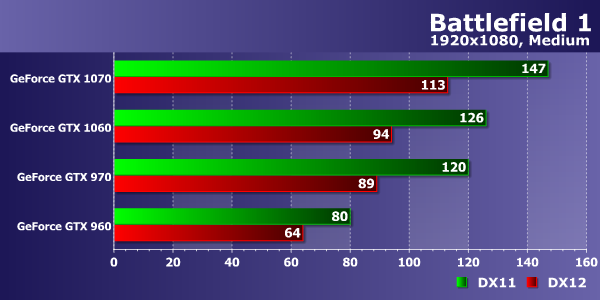
Rendering speed even in such simple conditions is almost not limited by the performance of the central processor, and video cards have been able to reveal their capabilities. Judging by the very first figures, the optimization of the game is simply excellent, and even the GeForce GTX 960, a mid-priced model of the previous generation, was able to easily cope with ensuring smooth frame changes in conditions of average graphics settings and the most common resolution, because the average frame rate in DirectX 11 mode on it was 80 FPS - exactly on the threshold of ideal smoothness.
It is logical that the other video cards on our list, being more powerful, in such simple conditions were able to provide even greater performance in the game with frame changes at speeds of 120 FPS on average and higher. That is, with such settings, the speed on all solutions will definitely never be lower than 60 FPS, which indicates the maximum possible comfort with an average profile of graphic settings. But the difference between DirectX 12 and DirectX 11 for GeForce video cards is clearly not in favor of the newer API - in this mode FPS for all Nvidia solutions turned out to be noticeably lower than using DirectX 11. So there is no point in using a DX12 renderer in the game yet; it needs to be seriously optimized.
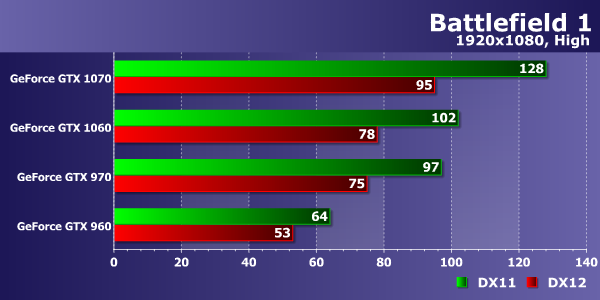
At high quality settings, the frame rate decreased, and the youngest of the Gigabyte video cards reviewed was already only able to provide a level of comfort sufficient for undemanding players in a single-player campaign. The GeForce GTX 960 was able to show 64 FPS on average with the possibility of the frame rate dropping to 40-45 FPS. Although this is not the minimum 60 FPS, it will be quite enough for most users.
The other video cards in comparison are more powerful, and all of them were able to show about 100 or more frames per second on average, which provides maximum comfort and a stable 60 FPS when playing, at a minimum. The GeForce GTX 1060 and GTX 1070, as well as the outdated GTX 970, were able to provide very high performance at 100-130 FPS on average, which is even higher than the level of ideal smoothness. The difference in speed between DX11 and DX12 decreased slightly, since in such conditions the speed is more dependent on the GPU, but remained clearly in favor of the old graphics API. Let's see what changes when setting the maximum Ultra quality profile.
![]()
The frame rate in the case of installing the ultra-profile settings decreased even more, but the values remained relatively high - we especially note the game’s perfectly balanced graphics settings, which do not have such values that bring even powerful GPUs to their knees. The performance of the GeForce GTX 960 model in such conditions provides acceptable comfort with almost 60 FPS on average, although only in DirectX 11 mode, and this is a pretty good level of performance for a single-player campaign in Battlefield 1 - even the mid-priced model of the previous generation allows you to play comfortably with maximum rendering quality.
A pair of powerful video cards of the current generation, like the GeForce GTX 970, work great in the most difficult conditions, providing 88-116 FPS on average, which still corresponds to the level of maximum comfort with a minimum of 60 FPS. That is, when using the three most powerful video cards, even with ultra settings, there will be no drops in frame rate below 60 FPS, which allows you to get ideal comfort when viewing the maximum possible quality. Difference between DirectX versions has become a little smaller, but the old version of the API is still much more profitable for real use.
Resolution 2560x1440 (WQHD)
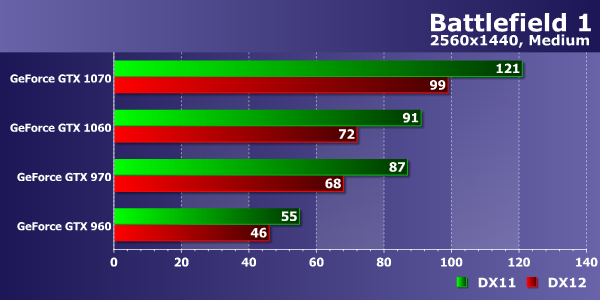
When choosing a higher rendering resolution of 2560x1440 pixels, the performance of all Gigabyte solutions in the game seriously decreased, which confirms the emphasis on performance in power. GPUs. At this resolution, all video cards are no longer limited by the capabilities of the CPU. The younger comparison model in the form of the GeForce GTX 960 in WQHD resolution conditions was still able to cope with the task of providing more than 45 FPS on average, showing 10 FPS more performance, which can be considered a good result.
The situation with the other video cards is even better; all three (GTX 970, GTX 1060 and GTX 1070) provide 87-121 FPS on average, that is, players will receive maximum comfort and smoothness with a stable minimum of 60 FPS. And again, older solutions from Gigabyte provided maximum comfort in higher resolutions only if a DX11 renderer was used, and the inclusion of DirectX 12 once again does not provide advantages in either speed or quality.
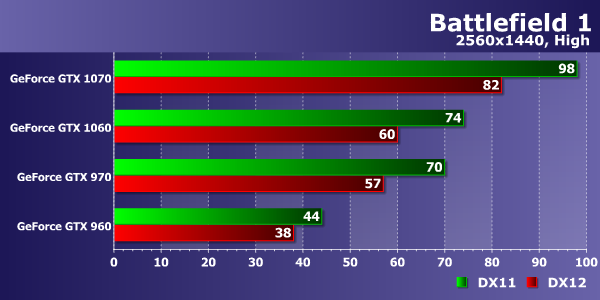
When playing with high quality settings in WQHD resolution, the weakest video card in our comparison was slightly lacking in performance. The GeForce GTX 960 achieved 44 FPS in this mode, which is only 1 FPS below our minimum acceptable level. In general, with some stretch we can consider this level to be minimally playable, especially if you slightly lower one of the available graphics settings, which will give the necessary increase to maintain a minimum of 30 FPS. The difference between DX11 and DX12 is still in favor old version API.
The power of more expensive graphics processors of different families, including one of the most successful models of the previous generation in the form of the GeForce GTX 970, is no longer always enough to ensure the highest possible smoothness with a minimum of 60 frames per second. GeForce GTX 970 and GTX 1060 showed a frame rate noticeably more than 45 FPS on average, but there will no longer be a stable 60 FPS in the game on them, because with a frame rate of 70-74 FPS in the test, the minimum value in the game will definitely fall below 60 FPS and To do this, you will have to lower one or two graphics settings to a medium level. Maximum comfort and high picture quality can only be achieved on a GeForce GTX 1070, which under these conditions showed 98 FPS on average, ensuring maximum smoothness.
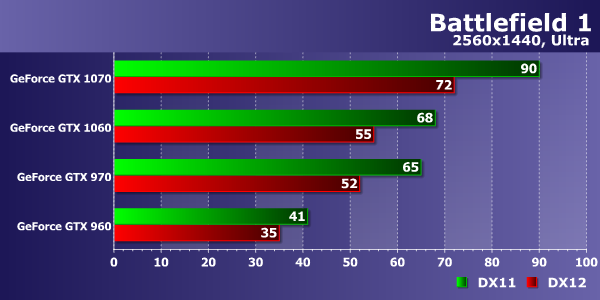
When installing the Ultra quality settings profile in WQHD resolution, the weakest solution in today's comparison showed a speed of 41 FPS, which cannot be considered comfortable, since such an average frame rate means possible drops minimum value below 30 FPS, which is extremely unpleasant in Battlefield 1, since the mouse will already respond too sluggishly to the player’s actions. So owners of such video cards and WQHD monitors will have to lower the settings. At the same time, it seems very likely that 4 GB of video memory is sufficient here; the rendering speed of a video card with such a capacity was not limited by it, and we did not notice any particular shortage of video memory. The difference between DirectX 11 and 12 remains.
The two GeForce video cards from our comparison, which have average power (GeForce GTX 970 and GTX 1060), coped with the task of providing minimally acceptable comfort and smoothness, showing in such conditions more than 60 frames per second on average with a minimum of above 30 FPS, which will be quite enough for a comfortable game for undemanding players who do not place excessive demands on the smoothness of the gameplay. Only the older solution in the form of the GeForce GTX 1070 reached ideal comfort at a minimum of 60 FPS, which showed a high 90 FPS on average (in DirectX 11 mode) - excellent result, corresponding to the top level!
Conclusion
Judging by the results of our tests, Battlefield 1 is well optimized for modern gaming PCs and has a good balance of graphic settings, which allows you to get high speed frame changes on the entire variety of modern video cards: from the weakest to the most powerful. The image quality in the game, even at medium settings, is very high, and at maximum it often approaches cinematic realism. The game makes good use of the possibilities multi-core processors, without being limited by the speed of its individual cores, and even if all CPU cores are loaded, the overall frame rate will be quite high.
But with DirectX 12 support it turned out worse. Although the game Battlefield 1 supports new version graphics API, but this renderer is no different from the DirectX 11 renderer in better side, neither in speed nor in capabilities, although it uses a new low-level API. Alas, the negative impact due to the general “crudeness” of such APIs could not be avoided - probably due to insufficiently good optimization of this renderer, in Battlefield 1 on GeForce video cards Not only did we experience slightly lower performance on average, but we also noticed worse overall game smoothness when FPS stuttering was too noticeable.
Such problems are unpleasant in a single-player campaign, and completely unacceptable in a multiplayer game, not to mention the fact that using DirectX 12, levels take a little longer to load, and the game may occasionally crash to the desktop. Taking all this into account, we simply do not see any point in using this renderer in its current form, and do not recommend using DX12 in Battlefield 1 at all. And in general, it is not very clear why the developers from DICE took so long to achieve the appearance of low-level graphics APIs on PC, even if they couldn't squeeze anything good out of them.
But when using DirectX 11, the game works just fine and looks very good! Even entry-level video cards like Radeon RX 460 and GeForce GTX 1050 give excellent performance at high quality settings in Full HD resolution, especially if an undemanding player needs a minimum of 30 frames per second with an average of 45-50 FPS. And the old solutions top level, like the GeForce GTX 970 and Radeon R9 390, allow you to play comfortably in almost any conditions. Radeon RX 480 and GeForce GTX 1060 will allow you to play at a resolution of 2560x1440 pixels even with Ultra settings, not to mention more powerful GPUs like the GTX 1070, which ensured speeds without dropping below 60 FPS under any conditions. Owners of less powerful graphics cards can customize the game using a variety of fine graphics settings.
In general, the game did not seem overly demanding to us; it does not rely on single-threaded performance, and makes excellent use of the multi-core CPU. The game's GPU performance requirements are at typical modern levels, even slightly lower. Therefore, for playing in Full HD resolution at any settings, we can recommend everything Gigabyte video cards, starting from the GeForce GTX 960 and GTX 1050. Under the lightest conditions with medium quality settings in Full HD and WQHD resolutions, all Gigabyte solutions reviewed showed sufficient performance for smooth gaming, and only starting with high settings in higher resolutions is it better to use video cards of the models GeForce GTX 1060 and GTX 970. The most powerful solution in the form of the GeForce GTX 1070 will provide perfectly smooth frame changes even in the most difficult conditions - with ultra settings in WQHD resolution.
Concerning central processing units, then the game Battlefield 1 has enough capabilities of mid- and upper-mid-level processors, but at least four cores are very useful for it. During our research, our test processor was loaded with work at an average level of 45%-50%, and even higher, but the rendering speed was not limited by the capabilities of only one of the CPU cores, and all this did not limit the frame rate in most cases , since the processor cores are loaded with work evenly, and the speed of the CPU is only possible with medium settings and very powerful GPUs like the GeForce GTX 1070.
The RAM requirements for modern games are familiar: system memory the game requires a minimum of 8 GB, since Battlefield 1 itself consumes at least 6-7 gigabytes of RAM. But there is no more reserve left, and therefore it is still recommended to have 12-16 GB of RAM. The game's video memory requirements are low by modern standards - at medium settings in Full HD it will require 2 GB of video memory, for higher picture quality at maximum settings it will require 3 GB, but in ultra-quality conditions and high WQHD resolution the game can already use 4 GB of video memory or more.







